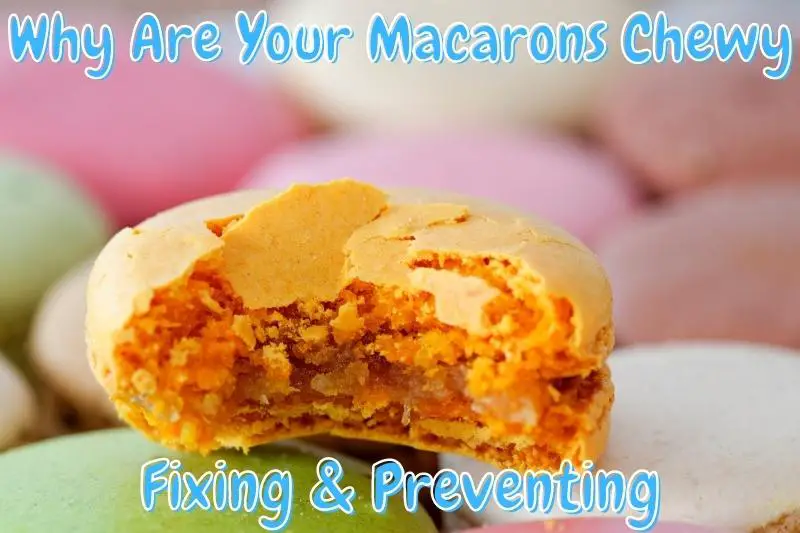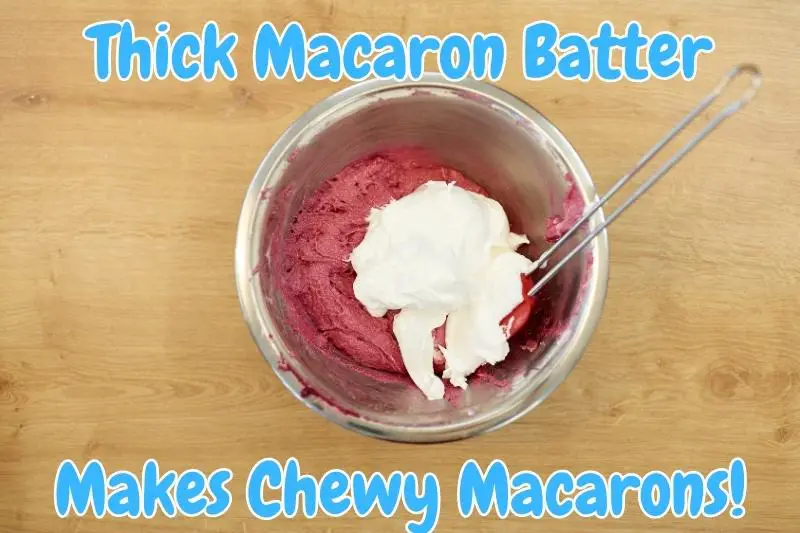This post contains affiliate links.
If you’ve ever made macarons, then you know that they can be a bit of a challenge. Especially if you’ve ever had them come out too chewy, then you’re not alone. In this article, I will discuss why your macarons might be coming out chewy and how to fix them.
Generally speaking, the most common reason why macarons are chewy is overbaking. When you overbake macarons, the outside gets hard and the inside stays moist and chewy. To prevent this from happening, make sure to bake them for the recommended time and then take them out of the oven immediately.
There are several other reasons why your macarons might be chewy. I’ve experienced many chewy macarons over the years, it almost felt impossible to get right! After much experimentation, I have figured out the best ways to fix and prevent them from happening.
Why Are My Macarons Flat And Chewy?
Macarons are one of the most difficult desserts to master because of all the things that could go wrong.
I’ve realized that one of the most common problems is a chewy macaron center which is a major nuisance!

Here are the major reasons why your macarons might come out flat and chewy:
- You Didn’t Mix The Batter Properly
- You Overbaked The Macarons
- The Macaron Batter Was Too Thick
- The Oven Temperature Was Too High
- There Were Some Meringue Issues
- You Didn’t Use The Right Ingredients
Even though there are many factors that could affect the chewiness of your macarons, there are simple ways to prevent them from ever happening in the first place.
You Didn’t Mix The Macaron Batter Properly
Mixing is key when it comes to making macarons. If you don’t mix the batter properly, the macarons will be flat and chewy. Make sure to mix the batter until it’s smooth and there are no lumps.
When mixing the batter, make sure you use egg whites at room temperature. Room-temperature egg whites will mix better and result in a fluffier batter.
You can use a food processor or a stand mixer with a whisk attachment to mix the batter.
*Side Note: I can’t go a day without using my Food Processor in my kitchen. They are great for anything from making pie dough to crushing walnuts! I use the Cuisinart Elemental 8-Cup Food Processor that you can check out on Amazon!
You Overbaked The Macarons
Overbaking is the most common reason why macarons come out flat and chewy. When you overbake them, the outside gets hard and the inside stays moist and chewy.
You can also use an oven thermometer to make sure the oven is at the correct temperature.
To prevent overbaking, make sure to bake them for the recommended time and then take them out of the oven immediately.
Overbaking will also lead to cracked macarons.
*By the way, I recently wrote an article explaining Why Your Macarons Could Have Cracked on Top. In this article, I break down all the different ways to fix and prevent cracked macarons in every scenario. You can check out this article here!
The Macaron Batter Was Too Thick
Your batter needs to be the right consistency for the macarons to turn out correctly.
If your batter is too thick, the macarons will be flat and chewy. If your batter is too thin, the macarons will spread too much and won’t hold their shape.

To get the right consistency, make sure you follow the recipe to a T. Use a food scale to measure the ingredients, and don’t add anything that’s not in the recipe.
I avoid all of these issues by simply using a Digital Scale which is a lifesaver in my kitchen. I recommend using a Nicewell Digital Food Scale which runs on batteries making it a wireless, hassle-free option. You can find it on Amazon!
The Oven Temperature Was Too High
Oven temperature plays a big role in how your macarons turn out. If the oven temperature is too high, the macarons will spread too much and will be flat and chewy.
The right oven temperature for macarons is around 300-325°F (150-163°C)!
Below is a chart I made that demonstrates the corresponding temperatures and baking times:
| Temperature | Baking Time |
|---|---|
| 285 Degrees Fahrenheit | 12-15 Minutes |
| 300 Degrees Fahrenheit | 10-13 Minutes |
| 325 Degrees Fahrenheit | 8-12 Minutes |
| 340 Degrees Fahrenheit | 7-10 Minutes |
You want to preheat the oven to this temperature and then bake the macarons at this temperature. Use an oven thermometer to make sure the oven is at the correct temperature.
You need to invest in an oven thermometer to judge the true temperature of the inside of your oven. This will help you get to know your oven better! I recently came across a great Stainless Steel Instant Read Oven Thermometer. You can check it out on Amazon!
There Were Some Meringue Issues
The meringue is what gives macarons their light and airy texture. If the meringue is not made correctly, the macarons will be dense and chewy.

To make the meringue, make sure you use egg whites that are at room temperature. Room-temperature egg whites will whip up better and result in a fluffier meringue.
You Didn’t Use The Right Ingredients
The recipe for macarons is pretty simple, but you need to use the right ingredients. The most important ingredient is almond flour. Almond flour is what gives macarons their signature flavor and texture.
Do not substitute almond flour for another type of flour, such as all-purpose flour. All-purpose flour will not give you the same results!
*By the way, I recently wrote an article about How to Aerate & Measure Flour The Right Way. This article talks about all the things you need to know to make sure you properly use flour when baking. You can check out this article here!
Are Macarons Supposed To Be Chewy?
While macrons are generally chewy in nature, the overall texture should not be overly chewy to the point where it’s tough to bite into. If your macarons are tough to bite into and get stuck to your teeth, it’s likely that they were overbaked or the macaron batter was too thick.
A well-made macaron should have a delicate and crisp exterior shell, but when you bite into it, the interior should be slightly chewy and moist.
Below I found a quick video that explains the right way of baking a macaron with a perfect center:
*By the way, if you’re looking for some new cookie sheets/baking pans to replace for your kitchen, I recently came across the Perfect Nonstick Cookie Sheets / Baking Sheets Set that I got for myself and they work great! You can check out these Nonstick Cookie Sheet Set on Amazon!
How Do You Fix Chewy Macarons?
To fix chewy macarons, consider rebaking them briefly at a low temperature, dehumidifying them using rice or bread, or exposing them to air for a short period of time. Doing these things will reduce the moisture in the macarons which will reduce their chewiness overall.
Generally speaking, it is hard to fix macrons that have turned out chewy. If they are only slightly chewy, you can try leaving them out on the countertop overnight and see if that helps.
I usually like to use thicker macaron filling to mask the chewiness of some of my macaron batches.
Fillings such as buttercream, ganache, or jam will help to make the overall texture smoother and more creamy.
After doing some research on the perfect filling for macarons, indulgewithmimi said:
“Depending on the filling, macaron fillings are usually made from sugar, eggs, chocolate, egg whites, real fruit, extracts, cream cheese and more.”
indulgewithmimi
To me, this means that there is no one real perfect filling for macarons, as long as the texture of the overall macaron cookie is right!
Achieving the right texture can be challenging, and it’s important to find the right balance between the crisp shell and the chewy interior. If they are very chewy, you might want to make a new batch.
*By the way, I recently wrote an article explaining Why Your Macarons Could Turn Out Crunchy When Done. In this article, I break down all the different ways to fix and prevent overly crunchy macarons in every scenario. You can check out this article here!
How Do You Keep Macarons From Getting Chewy?
As a general rule, you can prevent macarons from becoming excessively chewy by following the macaron recipe precisely. You can do this by ensuring proper baking time and temperature, maintaining meringue consistency, allowing shells to rest, cooling before filling, and using quality ingredients.
To prevent your macarons from getting chewy, make sure to follow the recipe to a T. Use a food scale to measure the ingredients, and don’t add anything that’s not in the recipe.
Humidity control is also vital, and avoiding humid days helps achieve the desired texture.
When mixing the batter, make sure you use egg whites at room temperature. Room-temperature egg whites will mix better and result in a fluffier batter.
You can use a food processor or a stand mixer with a whisk attachment to mix the batter.

While I like to do my mixing by hand, I much rather prefer using a Stand Mixer instead. I recently wrote an article that talks about the 3 Best Stand Mixers that bakers can buy in each stage of their baking journey. After reviewing a few stand mixers, the Best Overall Mixer was the KitchenAid Artisan Tilt-Head Stand Mixer. You can check out this stand mixer on Amazon!
Bake the macarons at the recommended temperature and for the recommended time. The right temperature for baking macrons is between 300-325°F (150-163°C).
Use an oven thermometer to make sure the oven is at the correct temperature.
Allow the macarons to cool completely before removing them from the baking sheet. If you try to remove them while they are still warm, they will stick to the baking sheet and become misshapen.
Practicing these steps yields macarons with a delicate exterior and balanced, non-chewy texture.
*Side Note: I recently wrote an article breaking down 10 Simple Ways To Make Sure Your Macarons Rise Evenly. In this article, I talk about all the different ways to fix and prevent flat macarons in every scenario and make sure they rise to their fullest potential. You can check out this article here!
How Do You Know When A Macaron Is Cooked?
As a general rule, you can determine that a macaron is cooked when it has a smooth and glossy appearance. The macaron’s color should be uniform without excessive browning, and the macaron’s texture should be slightly chewy but not wet or undercooked on the inside.
I also noticed that the macaron should have a defined “foot,” which is the bottom of the macaron, that can easily be released from the baking surface when done.
Cooked macrons should form a light crust on the outside and be cooked all the way through.

To test if they are cooked, gently touch the top of the macron. The macarons should be firm and non-wobbly on top when touched.
If it feels firm to the touch and does not give at all, then it is cooked. If there is any give or it feels mushy, then it needs to be cooked for longer.
Oven variations and recipe specifics might require adjustments to achieve the ideal outcome!
*By the way, I recently wrote an article explaining How To Prevent Your Macarons From Sticking To The Baking Paper. In this article, I break down all the different ways to prevent having sticky macarons and what to do to avoid it every time. You can check out this article here!
People also ask me…
Why are my macarons crunchy?
Macarons can become crunchy due to overbaking, which can dry them out and make them excessively crisp. Overmixing the batter can also cause the macarons to be crunchy when done. Make sure to mix the batter until there are no more streaks of egg white and bake it according to the recipe.
Can you put macarons back in the oven?
Generally speaking, you can put macarons back in the oven to make adjustments to their texture if they haven’t turned out as desired. Both underbaked and overbaked macarons can be placed back in the oven for a short period at a low temperature to help fix their textures.
Should macarons be moist?
In general, macarons should be slightly moist inside, but they should not be wet or overly moist. The ideal macaron has a crisp exterior shell and a slightly chewy, moist interior. The moisture comes from the combination of almond flour, egg whites, and sugar used in making the macaron shells.
How do you soften hard macarons?
To soften hard macarons, put the macarons in an airtight container enclosed with a damp paper towel and store them in the fridge overnight. The hard macarons should absorb the humidity from the wet paper towel making them softer and more moist the next day.
